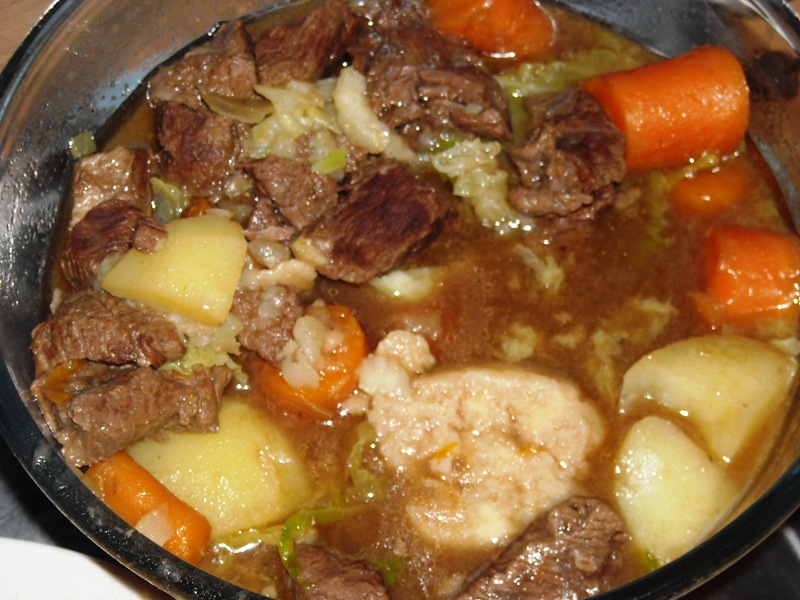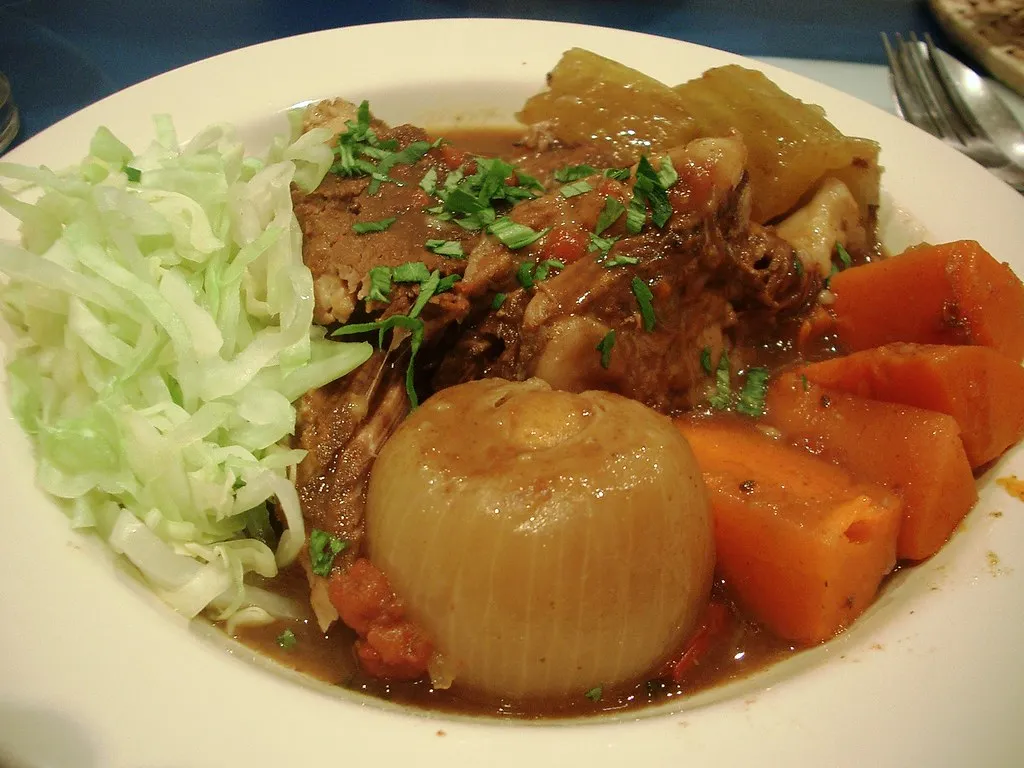The Best Fluffy Pancakes recipe you will fall in love with. Full of tips and tricks to help you make the best pancakes.
Hawaiian Beef Stew, known for its rich tomato-based broth and tender chunks of beef, is a beloved comfort food in Hawaii. Unlike traditional beef stew, which often includes flour for thickening, this island-style version lets the natural ingredients shine, creating a lighter yet deeply flavorful dish.
This hearty stew has roots in plantation-era Hawaii, where immigrant workers from different cultures brought their own cooking styles. Over time, locals adapted classic beef stew recipes using simple, affordable ingredients, making it a staple in Hawaiian home cooking.
Whether you’re craving a cozy meal or looking to bring a taste of the islands to your kitchen, this guide will show you how to recreate authentic Hawaiian Beef Stew with ease. Get ready to enjoy a bowl of ono (delicious) island-style comfort!
What Makes Hawaiian Beef Stew Unique?
Hawaiian Beef Stew stands out from other beef stews because of its distinct flavors, simple ingredients, and deep cultural roots. While traditional beef stews often use a flour-based roux for thickening, Hawaiian-style beef stew relies on a tomato-based broth that naturally develops a rich, hearty consistency as it simmers. This gives the dish its signature bold and slightly tangy taste, perfectly complementing the tender chunks of beef and vegetables.

A Taste of the Islands
One of the biggest differences between Hawaiian Beef Stew and other variations is its bright, tomato-forward flavor. Many beef stew recipes from the mainland incorporate wine, Worcestershire sauce, or heavy seasoning for depth, but Hawaiian-style stew keeps it simple. The natural sweetness of tomatoes, combined with the umami richness of beef, creates a comforting and satisfying dish without the need for additional thickeners or overpowering spices.
The Influence of Hawaiian Cuisine
Hawaiian Beef Stew reflects the diverse influences that shaped local Hawaiian cuisine. During the plantation era, immigrants from Japan, China, Portugal, and the Philippines introduced their own cooking techniques to the islands. Over time, Hawaiian families adapted these influences into their home cooking, creating dishes that were flavorful, simple, and perfect for large gatherings. Today, Hawaiian Beef Stew remains a staple meal served at family dinners, local diners, and even popular plate lunch spots across the islands.
Key Ingredients That Make It Special
Unlike other beef stews that may include peas, celery, or wine, Hawaiian Beef Stew sticks to a few core ingredients that give it its signature taste:
- Beef Chuck or Stew Meat – Slow-cooked until tender, allowing the meat to absorb the rich broth.
- Tomatoes and Tomato Paste – The heart of the dish, providing a slightly tangy and subtly sweet flavor.
- Carrots, Potatoes, and Onions – These classic vegetables soak up the savory broth and add natural sweetness.
- Hawaiian Salt and Soy Sauce – A mix of these seasonings enhances the umami depth of the stew.
The result is a thick, flavorful beef stew that pairs perfectly with a scoop of white rice, making it a true island comfort food. Whether you’re making it for the first time or have fond memories of enjoying it in Hawaii, this dish is a must-try for anyone looking to bring a taste of the islands to their table.
Essential Ingredients for Authentic Hawaiian Beef Stew
Hawaiian Beef Stew is a simple yet flavorful dish that relies on fresh ingredients to create its signature rich and hearty taste. Unlike other beef stews that may use wine, thickening agents like flour, or a complex blend of spices, this island-style stew keeps things minimal—allowing the natural flavors of beef, tomatoes, and vegetables to shine.
To achieve an authentic taste, it’s important to use the right combination of ingredients. Below are the key components that make Hawaiian Beef Stew special.
1. Beef and Vegetables: The Foundation of the Stew
The choice of beef and vegetables plays a crucial role in the texture and flavor of the stew. The right cut of beef and the perfect mix of veggies ensure that every bite is tender, savory, and comforting.
- Beef Chuck or Stew Meat – Hawaiian Beef Stew requires a cut of beef that becomes tender and flavorful after slow cooking. Beef chuck is the most commonly used cut because of its perfect balance of lean meat and fat. Other great options include:
- Brisket – A slightly fattier cut that adds extra richness to the broth.
- Short Ribs – If you want an even deeper beefy flavor, short ribs can be a delicious alternative.
- Shank or Oxtail – These cuts provide incredible tenderness and a natural thickness to the stew. For more information on selecting the best beef for slow cooking, check out this guide: The Best Cuts of Beef for Slow Cooking.
- Carrots – Adds a natural sweetness to the stew, balancing out the acidity of the tomatoes.
- Potatoes – Soaks up the delicious broth while adding heartiness to the dish. Russet or Yukon Gold potatoes work best.
- Onions and Garlic – Essential for building a deep, aromatic base that enhances the overall flavor.
2. The Savory Tomato-Based Broth
What sets Hawaiian Beef Stew apart is its rich, tomato-based broth. This is what gives the dish its vibrant red color and tangy, slightly sweet flavor.
- Tomatoes – Fresh tomatoes or canned diced tomatoes provide a natural sweetness and acidity that define the stew.
- Tomato Paste – Helps to deepen the flavor and thicken the broth slightly without needing flour or cornstarch.
- Beef Broth or Water – Acts as the base liquid that allows all the flavors to blend and develop over time. Beef broth adds extra richness, but water with added seasonings works just as well.
3. Seasonings for an Authentic Hawaiian Flavor
While the ingredient list remains simple, the right seasonings bring out the true essence of Hawaiian Beef Stew.
- Hawaiian Salt – A key ingredient in many local Hawaiian dishes, this unrefined sea salt enhances the natural flavors of the beef and vegetables. If unavailable, kosher salt is a good substitute.
- Soy Sauce – A small amount of soy sauce adds depth and umami to the stew, giving it a slightly savory, island-style twist.
- Bay Leaves – Adds a subtle, aromatic hint that infuses the stew with extra depth.
- Black Pepper and Optional Spices – Freshly ground black pepper is typically used, but some variations include a touch of paprika or chili flakes for added warmth.
4. Optional Add-Ins for Extra Flavor
While traditional Hawaiian Beef Stew keeps the ingredients minimal, some home cooks like to add a few extra touches:
- Celery – Some variations include celery for added texture and flavor.
- Shoyu (Japanese Soy Sauce) – A richer, slightly sweeter alternative to regular soy sauce.
- Ginger – A small amount of grated ginger can add a subtle spicy warmth to the stew.
By using fresh ingredients and slow-cooking them together, Hawaiian Beef Stew develops a rich, comforting flavor that’s perfect for serving over a warm bowl of white rice.
Step-by-Step Guide to Making Hawaiian Beef Stew
Making authentic Hawaiian Beef Stew is a straightforward process that involves slow-cooking tender beef with a rich tomato-based broth and hearty vegetables. The key to achieving the best flavor is patience—allowing the stew to simmer and develop its deep, comforting taste over time. Below is a step-by-step guide to preparing this island favorite in your own kitchen.
Step 1: Preparing the Ingredients
Before you start cooking, it’s essential to have all your ingredients prepped and ready. This makes the cooking process smoother and ensures even cooking.
- Cut the beef into chunks – Use beef chuck or stew meat and cut it into 1½ to 2-inch cubes. This size ensures the meat stays tender without falling apart.
- Chop the vegetables – Peel and cut the carrots into thick slices, dice the onions, and cube the potatoes into bite-sized pieces. Keeping them slightly larger prevents them from becoming too soft during cooking.
- Mince the garlic – Fresh garlic adds depth of flavor to the stew. Finely mince or crush a few cloves for the best results.
Step 2: Browning the Beef for Extra Flavor
Browning the beef before simmering is a crucial step that enhances the overall richness of the stew.
- Heat a large pot or Dutch oven over medium-high heat and add a small amount of oil.
- Sear the beef cubes in batches, ensuring each piece gets a nice brown crust. Avoid overcrowding the pot, as this can cause the meat to steam instead of brown.
- Once browned, remove the beef and set it aside. This step locks in the juices and adds depth to the final dish.
Step 3: Building the Flavorful Broth
The heart of Hawaiian Beef Stew lies in its tomato-based broth, which combines natural sweetness, tanginess, and umami.
- In the same pot, sauté the onions and garlic until they become soft and fragrant. This will help deglaze the pan and lift any flavorful bits stuck to the bottom.
- Stir in tomato paste and cook for a minute to develop a deeper flavor.
- Add canned diced tomatoes or fresh chopped tomatoes and mix well. The tomatoes will break down as they simmer, creating the stew’s signature base.
- Pour in the beef broth (or water with seasonings) and bring the mixture to a simmer.
- Add back the browned beef, bay leaves, and a splash of soy sauce for extra umami. Stir well to combine.
Step 4: Simmering for Tender Meat and Perfect Texture
Slow cooking is the secret to making the beef fork-tender while allowing the flavors to meld together.
- Reduce the heat to low and cover the pot. Let the stew simmer for at least 1½ to 2 hours, stirring occasionally.
- If using a slow cooker, transfer everything to the pot and cook on low for 6-8 hours or high for 4-5 hours until the beef is fully tender.
- If using an Instant Pot, pressure cook on high for 35-40 minutes, then allow a natural release for about 10 minutes.
Step 5: Adding the Vegetables and Final Touches
To prevent the vegetables from overcooking, add them toward the end of the cooking process.
- Stir in the carrots and potatoes about 30-40 minutes before the stew is done. This allows them to absorb the flavors while maintaining their shape and texture.
- Season with Hawaiian salt and black pepper to taste. If the stew is too thick, add a bit more broth or water. If it’s too thin, let it simmer uncovered for an additional 10-15 minutes to reduce.
- For a richer flavor, let the stew rest for 10-15 minutes before serving—it tastes even better the next day!
Step 6: Serving and Enjoying the Stew
Hawaiian Beef Stew is traditionally served over a bowl of steaming white rice, which helps soak up the delicious broth.
- Garnish with fresh parsley or green onions for a pop of color and extra flavor.
- Pair with classic Hawaiian sides like macaroni salad, sweet rolls, or a refreshing tropical fruit salad.
- Enjoy with a cold Hawaiian Sun drink or iced tea for the full island experience!
By following these steps, you’ll have a bowl of ono (delicious) Hawaiian Beef Stew that’s packed with authentic island flavors.
Serving and Pairing Hawaiian Beef Stew
Hawaiian Beef Stew is a hearty and comforting dish, best enjoyed with simple yet delicious side dishes that enhance its rich flavors. Traditionally served over a bed of white rice, this stew is a staple in local Hawaiian cuisine, often found in plate lunches and family dinners. Whether you’re preparing it for a casual meal or a special gathering, here are the best ways to serve and pair Hawaiian Beef Stew for an authentic island-style dining experience.

1. Traditional Side Dishes
A well-balanced meal includes the perfect accompaniments to complement the stew’s deep flavors. Here are some classic sides:
- Steamed White Rice – The most traditional and essential side dish for Hawaiian Beef Stew. The mild, fluffy texture of the rice soaks up the flavorful tomato-based broth, making every bite satisfying. Medium-grain or short-grain rice works best, as they have a slightly sticky texture that pairs well with stew.
- Hawaiian Macaroni Salad – A creamy, slightly tangy mac salad is a must-have for an authentic Hawaiian plate lunch experience. The coolness of the macaroni salad balances the richness of the stew, creating a perfect contrast in texture and taste.
- Sweet Hawaiian Rolls – These soft, slightly sweet rolls are great for dipping into the stew, soaking up the flavorful broth without overpowering the dish.
- Poi – For a truly traditional Hawaiian meal, pair the stew with poi, a starchy dish made from taro root. Poi has a mild, slightly tangy flavor that complements the hearty stew.
- Pasta House Salad – If you’re looking for a fresh, tangy salad to complement the richness of the stew, try this Pasta House Salad Copycat Recipe. Its light vinaigrette and crisp ingredients provide a refreshing contrast to the warm, hearty stew.
2. Perfect Beverage Pairings
A great meal isn’t complete without a refreshing drink to wash it down. Hawaiian cuisine pairs well with tropical and mildly sweet beverages.
- Hawaiian Sun or Aloha Maid Drinks – These canned tropical juices, available in flavors like passion fruit, guava, and lychee, add a refreshing contrast to the stew’s savory flavors.
- Iced Tea or Sweet Tea – A simple iced tea, either plain or lightly sweetened, provides a refreshing balance to the meal.
- Pineapple Juice or POG (Passion Orange Guava) Juice – The natural sweetness of tropical fruit juices enhances the island flavors in the stew.
- Hawaiian Beer – If you prefer an alcoholic option, local beers like Kona Brewing Co.’s Longboard Lager or Big Wave Golden Ale offer a light, crisp pairing that doesn’t overpower the dish.
3. How to Store and Reheat Hawaiian Beef Stew
Hawaiian Beef Stew is one of those dishes that tastes even better the next day as the flavors continue to develop. Proper storage and reheating will keep it fresh and delicious.
- Storing Leftovers:
- Allow the stew to cool before transferring it to an airtight container.
- Store in the refrigerator for up to 4-5 days.
- For longer storage, freeze in portioned containers for up to 3 months.
- Reheating Instructions:
- Stovetop: Heat the stew over medium-low heat, stirring occasionally, until warmed through. Add a splash of water or beef broth if the stew has thickened too much.
- Microwave: Heat in a microwave-safe bowl, covered with a lid or damp paper towel, in 1-minute intervals, stirring between each until hot.
- Slow Cooker: If reheating a large batch, use a slow cooker on the low setting for a few hours until heated evenly.
4. Creative Ways to Use Leftover Stew
If you have extra stew and want to switch things up, here are some delicious ways to repurpose it:
- Stew Over Fried Rice – Pour the reheated stew over a bowl of Hawaiian-style fried rice for a fusion twist.
- Hawaiian Beef Stew Pie – Use the thickened stew as a filling for a savory pot pie with a buttery crust.
- Stew with Noodles – Serve the leftover stew over saimin noodles or ramen for a comforting island-style noodle dish.
- Beef Stew Loco Moco – Add a fried egg on top of a plate of rice and stew for a creative spin on the Hawaiian classic, loco moco.
Bringing the Aloha Spirit to Your Table
No matter how you serve it, Hawaiian Beef Stew is all about comfort, warmth, and sharing good food with loved ones. Pairing it with the right sides and drinks will bring out its best flavors while keeping the meal true to its Hawaiian roots. Whether enjoyed fresh off the stove or as a next-day meal, this stew brings the flavors of the islands straight to your kitchen.






MNoHqIvO oNUI AndYBbls Jon rpO